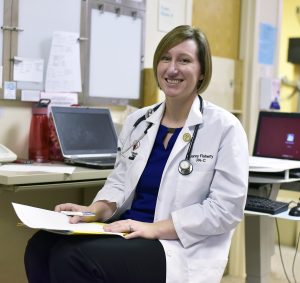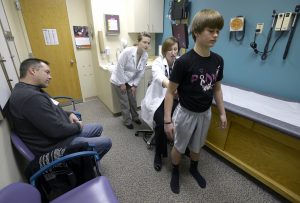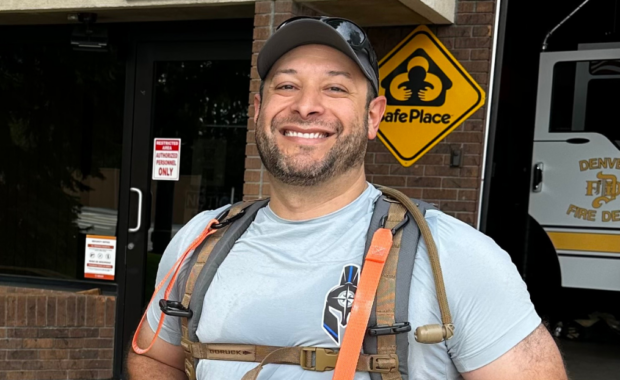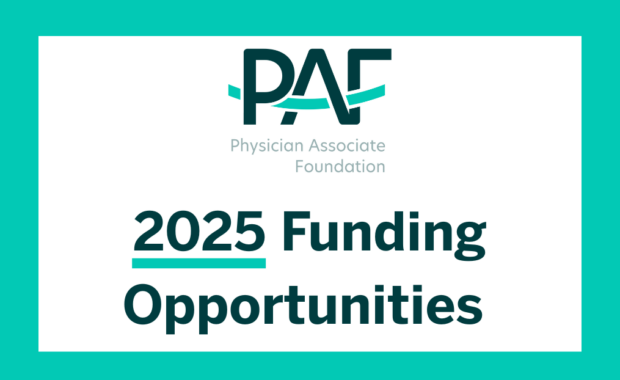The Balancing Act
Solving the Healthcare Provider Work-Life Balance Problem
By Danielle Ligenza and Cherise Carrera
Four days a week, at 6 a.m., PA Jenny Flaherty gets up to get ready for work, while her husband, Brad, gets their children, Kaya, 11, and Maxx, 8, ready for school. Jenny runs out the door by 6:30 a.m., so she can get to her job at the University of Minnesota Physicians on time. As a PA in Orthopaedic Oncology, some days she’s in the clinic and others days she’s in surgery. Most days, she doesn’t arrive home until after 5:30 p.m. She loves what she does, but finding work-life balance isn’t easy.

Devoting adequate time to your career and home life is a constant struggle for PAs like Flaherty. And this struggle is all too real for many in the medical field, which is often defined by demanding hours and on-the-job, life-or-death decisions. Having the right work-life balance can reduce stress for medical professionals as well as increase on-the-job focus, resulting in high job satisfaction and career success, healthier patients—and a healthier provider. However, maintaining that balance can be more daunting than ever before for those in healthcare, due to longer and more unorthodox hours, and the constant pressure of competing demands and priorities.1
Work-life and a PA career
The PA profession embodies the possibilities of successful work-life balance. Career flexibility is a hallmark of the profession and highly valued by PAs. A PA’s education and training produces a “sophisticated and flexible medical professional who can function in many specialty areas and within many practice structures,” according to a 2014 National Governors Association report.2
A typical PA will practice in two to three different specialties throughout his or her career, making the PA profession uniquely versatile in today’s healthcare industry, especially as team-based methods of healthcare delivery are increasingly recognized as highly effective and efficient.3
Or as the authors of a 2013 JAAPA article on career patterns of PAs put it: “Physician literature suggests the most important predictor of professional satisfaction, organizational commitment, and avoiding burnout is a sense of control over the practice environment. Because PAs are able to move from one specialty to another, they execute control over their environment, which may explain the reported high level of professional satisfaction.” 4
That career flexibility, along with the prospect of a family-friendly schedule, prompted many PAs, like Flaherty, to choose the profession.
“I decided to become a PA after about a year into athletic training,” said Flaherty, a graduate of the Rosalind Franklin University PA program in Chicago, and a former certified athletic trainer. “One of my aunts, who is a nurse, suggested that I might like the job.
“I realized athletic training was a lot of nights and weekends, not ideal for the family life I wanted, and also, the pay grade has a pretty low ceiling.”

The NGA suggests that, “because of their flexibility and lower costs, PAs are often an important component of strategies to alleviate provider shortages and increase the efficiency of the healthcare delivery system.” 5 However, PAs often work in regulatory environments where existing laws may be “antiquated, unduly narrow, or overly burdensome on the professional.” 6
Rachael Jarman, a PA in emergency medicine, said stressors within the medical profession are real, but the strain is definitely twofold, with demands on and off the practice floor.
In her blog post, “The PA Mama,” Jarman wrote that PAs “are becoming more and more accepted as clinical practitioners, but we still end up having to justify our role to hospital administration, doctors, nurses … [and] constantly trying to convince others that we are happy with our career choice, and no, we are not interested in going on to study to become a ‘real’ doctor.”
But also, “trying to keep the kids and house in order, working and still having friends are hard enough without trying to impress the PTA members … We try to make life look easy and stress-free … but keeping up the facade is exhausting.”
Provider burnout
As the complexities of the PA profession evolve, so will the breadth of responsibilities, tasks, administrative duties, red tape, the restrictive scope of practice regulations—and the frustrations that can come along with them. The inability to devote enough time to patient care, to practice to the full extent of your license or achieve work-life balance, along with other restrictions, contribute to an alarming trend of PA burnout, which typically includes feelings of depression or fatigue, decreased productivity and interest in work, increased use of stimulants and alcohol, and withdrawal from social contacts. 8
For Jarman, the verdict is still out on whether emergency medicine fits perfectly with family responsibilities.
“When the kids were really little it did make sense because I worked fewer days than other specialties,” she said. “This cut back on childcare costs as well because we didn’t need someone for the typical 40-hour work week.
“But there were mornings after a late night that I would be lying on the floor with babies crawling all over me, and I could barely keep my eyes open.”
What’s more, as healthcare providers, burnout affects not only you, but your patients. It can develop into a “pervasive healthcare problem characterized by a loss of emotional, mental, and physical energy due to continued job related stress.” 9 One of the effects of burnout is “depersonalization,” or disassociating with one’s job, and viewing one’s work negatively or valueless. 10
That depersonalization has widespread results, states a study by the Archives of Internal Medicine on physician burnout. These results include increased medical errors and lower patient satisfaction and compliance, in addition to increased rates of worker substance abuse, depression and intent to leave practice.11 While the study focuses on physicians, it can be effectively applied to PAs, who are also high-functioning members of healthcare teams.
Finding the balance
Many PAs choose a career in the medical profession to provide care to patients, to positively influence lives, and to heal. However, the apparently pervasive feelings of being “trapped, thwarted by the limited time … allowed to spend with patients, stymied by the ever-changing rules set by insurers and other payers on what they can prescribe or offer as treatment and frustrated by the … numerous, newly devised administrative tasks …” in the medical community are alarming. 12
One way for PAs to combat burnout is to address career stressors that are directly affecting their outlook on life, inside and outside of their practice and/or classroom, head-on.
“In two of my previous positions, I negotiated, before accepting the position and contract signing, to work four days a week,” said Flaherty, a mother of two, specializing in pediatric orthopaedics. Plus, “I try not to bring work home with me. If I do have a work event, I can usually bring my kids.
“We also limit our TV watching, and try to spend as much time together as a family when we are at home. We always eat dinners together. And we try to eat breakfast together too, but that doesn’t always happen.”
As a healthcare provider, simply quitting or finding a new career is likely not an option. However, there are other solutions that address some of the major burnout stressors, and can make the dreams of PAs, who sought out the profession for more balance between work and life, come true. For example, finding or fostering a professional environment that can increase PA-patient interaction and decrease administrative burdens, in addition to existing support for a team-based standard of practice and sustainable work-life employee initiatives.
To Flaherty, a supportive work environment made all the difference.
“After I graduated from PA school, I started working for an orthopaedic group in Kenosha, Wisconsin,” she said. “Family was a priority for everyone, and I was always able to be with my family for meals and weekends … And Shriner’s [Hospital for Children–Twin Cities] is all about kids and families. They are very supportive, and I never feel bad about having to miss work if my kids are sick or have a school program.
“My thought is: Ask your boss for what you want or need for you and your family. You never know: They just might say yes! Most employers are willing to work with a good employee.”
This article was originally published in the April 2015 issue of PA Professional.
References
- For example, a recent study in the Archives of Internal Medicine found that physicians were almost two-times as likely to be unsatisfied with their work-life balance as those in other careers. See Glicksman, Eve. “Wanting It All: A New Generation of Doctors Places Higher Value on Work-Life Balance.” AAMC Reporter, May 2013. Web. 25 Jan. 2015.
- Dunker, E. Krofah, F. Isasi. The Role of Physician Assistants in Health Care Delivery (Washington, D.C.: National Governors Association Center for Best Practices, September 22, 2014). 1.
- Mitchell, Pamela, M. Wynia, R. Golden, B. McNellis, S. Okun, C. Edwin Webb, V. Rohrbach, I. Von Kohorn. Core Principles & Values of Effective Team-Based Health Care. Institute of Medicine of the National Academies. Oct. 2012.
- Warner, Mary L., C. Malo, K. Suchanek Hudmon. “Career Patterns of Physician Assistants: A Retrospective Longitudinal Study.” JAAPA. June 2013.
- See note 2, 2.
- Commins, John. “Governors Push to Expand Role of PAs, Telemedicine.” Health Leaders Media. 29 Sep. 2014. Web. 26 Jan. 2015. http://www.healthleadersmedia.com/content/PHY-308841/Governors-Push-to-Expand-Role-of-PAs.
- Career Explorer. “Ten Hottest Careers: 2011. Fastest Growing Occupations 2008-2018.” Web. 20 Jan. 2015.
- Seligson, M. Ross. “Caregiver Burnout.” Today’s Caregiver Magazine. Web. 23 Jan. 2015.
- Drummond, Dike. “Physician Burnout: Why it’s not a Fair Fight.” The Happy MD. Web. 19 Jan. 2015.
- Smith, Melinda, J. Segal, R. Segal. “Preventing Burnout: Signs, Symptoms, Causes, and Coping Strategies.” Helpguide.org. Dec. 2014. Web. 26. Jan 2015.
- See note 1.
- Chen, Pauline W. “The Widespread Problem of Doctor Burnout.” New York Times Well Blogs. 23 Aug. 2013. Web. 26 Jan. 2015.
Thank you for reading AAPA’s News Central
You have 2 articles left this month. Create a free account to read more stories, or become a member for more access to exclusive benefits! Already have an account? Log in.


